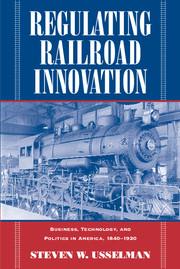Book contents
- Frontmatter
- Contents
- List of Illustrations
- Preface and Acknowledgments
- Introduction
- Part I ASSEMBLING THE MACHINE, 1840–1876
- Part II RUNNING THE MACHINE, 1876–1904
- Part III FRICTION IN THE MACHINE, 1904–1920
- 8 Reluctant Innovators: The Annoying Allure of Automatic Train Control
- 9 The Limits of Engineering: Rate Regulation and the Course of Innovation
- Epilogue: The Enduring Challenge of Innovation
- Index
9 - The Limits of Engineering: Rate Regulation and the Course of Innovation
from Part III - FRICTION IN THE MACHINE, 1904–1920
Published online by Cambridge University Press: 12 August 2009
- Frontmatter
- Contents
- List of Illustrations
- Preface and Acknowledgments
- Introduction
- Part I ASSEMBLING THE MACHINE, 1840–1876
- Part II RUNNING THE MACHINE, 1876–1904
- Part III FRICTION IN THE MACHINE, 1904–1920
- 8 Reluctant Innovators: The Annoying Allure of Automatic Train Control
- 9 The Limits of Engineering: Rate Regulation and the Course of Innovation
- Epilogue: The Enduring Challenge of Innovation
- Index
Summary
At the very moment the ICC signal board advocated imposing an unprecedented degree of government oversight upon railroad operating procedures, the commissioners themselves gathered in Washington to consider a matter of even more vital importance to American railroading. The occasion was the Eastern or Advance Rate Case, in which the ICC would exercise its new authority to set maximum rates for railroad transportation. Railroads in the densely settled northeastern third of the nation had petitioned for a 10 percent increase in all tariffs. As a parade of railroad executives and their hired experts testified to the need for increased revenue, they came under close scrutiny from Louis Brandeis, a savvy and experienced advocate retained by New England shippers and merchants who opposed the proposed rate hike. Like a skilled prosecutor, Brandeis peppered one witness after another with detailed queries regarding costs. The insistent cross-examiner attracted no special attention from the smothering press coverage, however, until he took the floor early that winter and proceeded to march his own stable of experts before the commission. Railroads did not in fact need the proposed rate increase, explained each authority in turn, because they could raise the same amount of funds simply by eliminating inefficiencies. The carriers could realize this startling savings – a million dollars a day, in the convenient shorthand of the press – by employing the methods of scientific management as espoused by engineering experts such as Frederick Winslow Taylor and Harrington Emerson.
- Type
- Chapter
- Information
- Regulating Railroad InnovationBusiness, Technology, and Politics in America, 1840–1920, pp. 327 - 380Publisher: Cambridge University PressPrint publication year: 2002



